Capitalizing on the right eCommerce trend can catapult your business to great heights. The learnings give one great insight into the right ways of eCommerce platform development. Amazon is one excellent example of a winner-takes-all in this ecosystem. It might be a slight exaggeration, but you can’t deny Amazon’s dominance in the eCommerce ecosystem. The situation demands you to note the latest trends and stay proactive.
The global eCommerce market will fetch sales of $5.9 Trillion with a growth rate of 8.9% this year. That’s a serious number, but getting even a small chunk of this pie needs you to be on top of your game. You need to be in tune with all the technological advancements along with consumer demands.
Identifying the right eCommerce trend is, therefore, the next big challenge you face. To overcome those challenges, Simform’s eCommerce specialists can help you ride the rising wave of eCommerce trends.
Let’s go through the eCommerce trends shaping the future of this industry as we speak.
It covers technologies that attract more shoppers and frameworks that help build better eCommerce ecosystems and attract more shoppers. I’ve also put together new strategies that eCommerce giants follow for more efficient marketing. So let’s dive right into the list:
It covers technologies that attract more shoppers, frameworks that help build better eCommerce ecosystems and attract more shoppers. I’ve also put together new strategies that eCommerce giants follow for more efficient marketing. So let’s dive right into the list:
#1. AR and VR’s immersive user experience increases product value
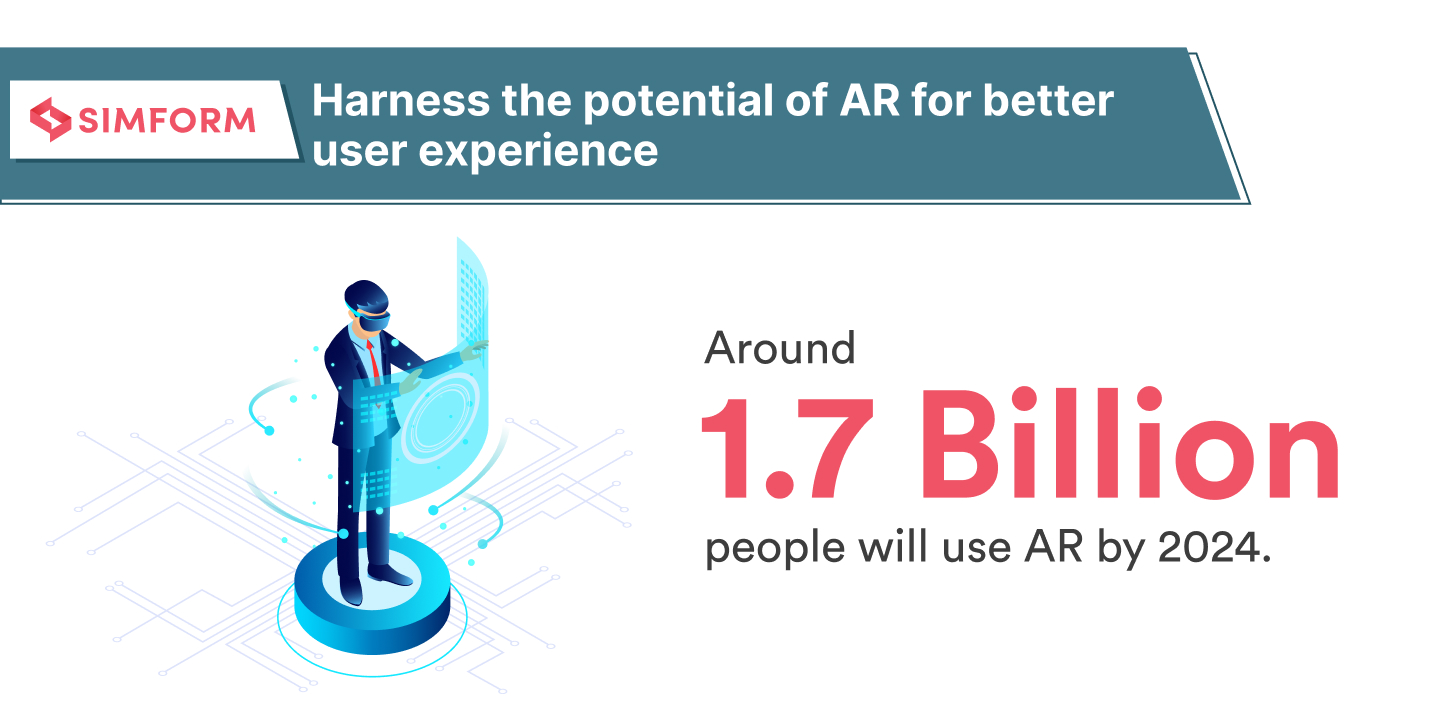 Do more than images and videos to get ahead of competitors: It hasn’t been long since videos got mainstream on eCommerce websites, and the trend has already started getting obsolete. AR and VR tower over most customer experience enhancing strategies. Perhaps the only way to beat these two technologies is to put the shopper in a real physical store.
Do more than images and videos to get ahead of competitors: It hasn’t been long since videos got mainstream on eCommerce websites, and the trend has already started getting obsolete. AR and VR tower over most customer experience enhancing strategies. Perhaps the only way to beat these two technologies is to put the shopper in a real physical store.
Allow customers to try before they buy: Consumers feel betrayed when their orders don’t turn out to be as they expected. It could either be a misfit, a difference in shade, or a poor build-quality, etc.
AR promotes the try-before-you-buy approach, setting realistic customer expectations. This, in turn, improves a brand’s image and boosts its sales. There will be around 1.7 billion AR users by 2024, and the time is ripe for eCommerce businesses to hop on this bandwagon.
Deliver a more immersive user experience: AR not only helps alleviate the issues mentioned but also boosts sales because of the immersive experience. Keep reading!
Improve brand popularity: Ikea launched IKEA Place, an AR app on the App Store, to make buying decisions easier for customers. It didn’t take long for the app to grab the second position on the chart for free apps on Apple’s ARKit. What makes this feat more remarkable is that IKEA Place left a lot of AR gaming apps behind to grab the spot. The immersive experience led to positive customer reviews on the app. The benefits make it difficult for anyone to ignore this retail eCommerce trend.

Increases product value: It’s not just furniture sellers like IKEA that benefit from AR. Sephora, a seller of cosmetics and beauty products, allows its customers to try the beauty products virtually.
In fact, a survey pointed out that 71% of consumers say that they would shop more if AR were a part of their shopping experience. Ergo, the possibilities are endless with AR.
More brands and customers are getting into VR: While AR is turning out to be a boon for eCommerce businesses, VR isn’t far behind.
The two eCommerce powerhouses – Alibaba and Amazon- have tried bringing online stores to life using VR. But these two are not the only brands; other players are also attempting to create virtual stores for shoppers. For this, they are continuously investing in technology.
Top brands like Ralph Lauren, Bloomingdale’s, Pinko, Tommy Hilfiger, and Lacoste have created virtual reality stores, features, tools, apps, and VR e-commerce shopping experiences.
The future of eCommerce seems to head the AR/VR way, and you can’t take eyes off this eCommerce technology trend.
#2. Smarter decisions from AI help boost sales
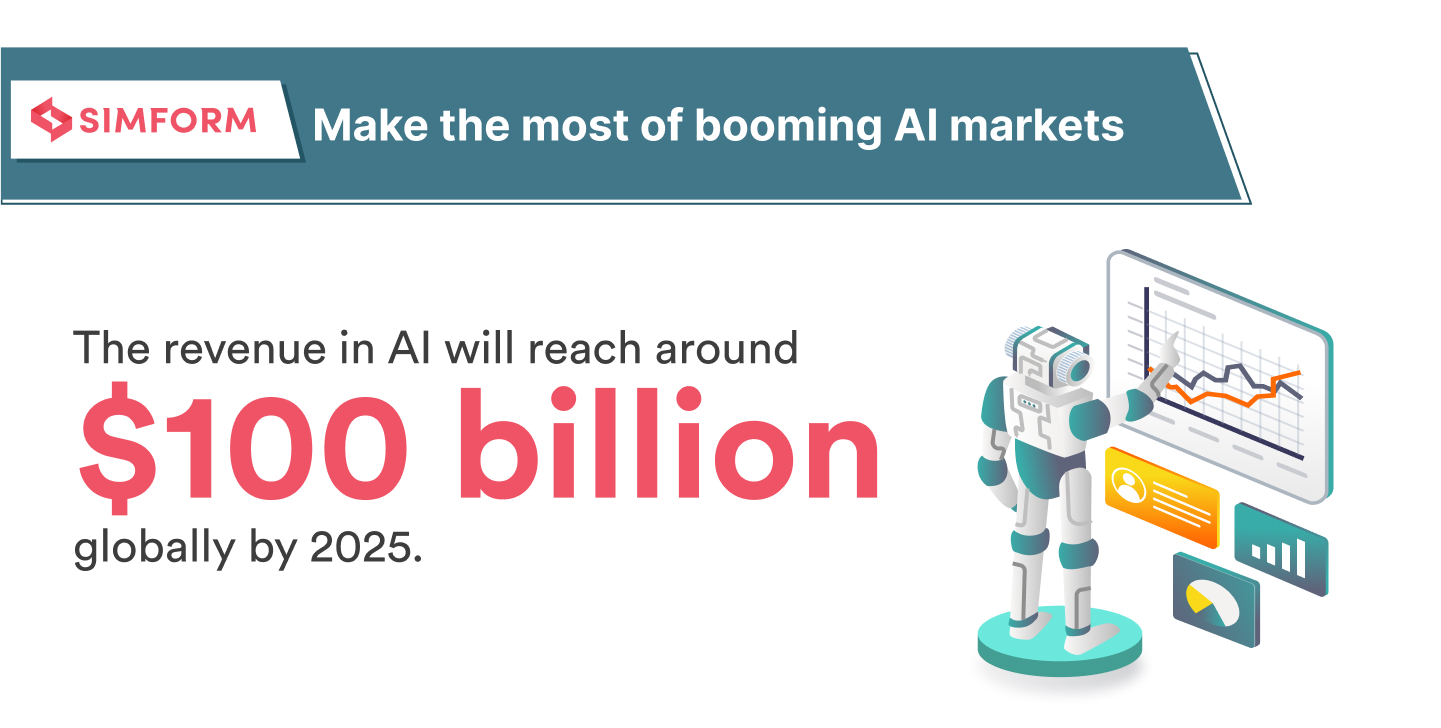 AI needs no advocate to signify its importance to the future of eCommerce. A lot of these eCommerce trends mentioned have a connection to AI. Be it voice search, chatbots, or even social commerce, AI enhances them all.
AI needs no advocate to signify its importance to the future of eCommerce. A lot of these eCommerce trends mentioned have a connection to AI. Be it voice search, chatbots, or even social commerce, AI enhances them all.
Improves efficiency and reduces costs: Big Data and Machine Learning (ML) are partners in crime to AI. The trio has helped countless businesses automate tasks that would’ve otherwise been impossible to do manually. For instance, Netflix uses machine learning algorithms to analyze your viewing habits and preferences, providing personalized recommendations that keep you engaged on their streaming platform longer.
Even AI can also lend a helping hand in travel planning. Take the example of ChatGPT. When using ChatGPT for travel planning, be specific in your queries, seek recommendations based on preferences, gather destination information, plan your itinerary, ask for travel tips, verify information, and supplement suggestions with your own research and professional advice.
But the advancements in AI are not just limited to traveling and entertainment. There are some more implications of AI agents in the real world. You can check them out here.
Create smarter strategies with predictive analytics: Predictive analytics is just one of the ways how AI can turn out to be a fruitful technology for eCommerce. Its other branches are behavioral analytics, automation, inventory management, and image recognition. It is because of the wide range of applications using it that the AI revenue is expected to reach nearly $100 billion globally by 2025.
Personalization to improve customer experience and customer loyalty: eCommerce Strategist, Ed Kennedy, says, “The main way it’s (AI) used is personalization. Personalizing the experience that a consumer sees when they come shopping on your website is powered by machine learning and AI in many many eCommerce sites.”
Suits all sizes of businesses:
eCommerce businesses, big and small, benefit greatly from using AI. The North Face is one of the leading outdoor recreation product retailers, which is a great example of an organization that improved its customer experience with AI.
Their platform is powered by IBM Watson, which helps visitors find the right product from their vast catalog. It asks shoppers the right questions and then provides relevant results.
Another great example is Wealthfront, a robo-advisor that offers goal-based investing, tax-loss harvesting, custom portfolios, and a high-interest cash management account with no fees.
Of all the old and new eCommerce technologies, AI is perhaps the most important among the trends of eCommerce.
#3. More payment methods reduce cart abandonment
Reduce cart abandonment with more payment methods: Credit cards have been synonymous with online payment for a long time. However, the emergence of payment modes like e-Wallets, bank transfers, prepaid cards, cash on delivery, and others alike compelled e-Commerce platforms to integrate these methods with their platform. And as if this wasn’t enough, cryptocurrency quickly gained popularity among internet dwellers.
All the abovementioned things can gradually spike cart abandonment rates. Even in March 2023, 72.77% of all online shopping carts failed to reach the checkout stage. Therefore, adding more payment modes to shrink your cart abandonment rate is a safe bet.
More payment methods lead to improved customer experience: If an eCommerce business wants to reach the top of the food chain, it can’t ignore any available payment technologies. It can quickly turn out to be a mammoth task to handle.
According to Forbes, one of the top four customer experience trends in 2023 is the increasing demand for a wider range of payment options among consumers. By offering a variety of payment methods, businesses can greatly enhance the ease of purchasing products or services for their customers.
Pick the right APMs to reduce legwork and increase sales: You need to identify the right Alternative Payment Models (APM) based on the target audience and other relevant factors. You also can’t keep security out of this debate, but thankfully most APMs come with enough security measures.
Modern payment mechanisms are getting increasingly popular among shoppers. So much so that you can expect these payment methodologies to remain in future eCommerce trends for a long time.
#4. Attract more customers with the hands-free voice search option
Get more customers with the hands-free experience: Nothing beats the convenience of interacting with a device as if interacting with another human being. Google Assistant, Alexa, Siri, and Cortana are becoming more mainstream.
Voice search utilizes Natural Language Processing (NLP) to better understand customers’ words and phrases, ensuring accurate results every time. With its ability to grasp the context and comprehend natural tones, voice search minimizes irrelevant suggestions and presents only the most relevant outcomes.
Becoming voice friendly now will give you more sales in the future. Moreover, retails and eCommerce businesses need to be voice-search-ready, which is non-negotiable. Furthermore, people have already started making purchases using voice search.
Natural Language Processing (NLP) will help you sell more products: A lot goes into an eCommerce business becoming voice-friendly. They need to work on NLP, using ML and AI for appropriate responses and ensuring user privacy. With these measures in place, it will be easier for users to find your products. Consequently, you get to sell more products.
Leverage existing voice search tools to grow your business: Domino’s proactively capitalized on this hands-free technology. They allowed people to dictate orders to their devices, making ordering pizza simpler and more convenient. They leveraged the existing voice assistant ecosystem to boost business– a move all eCommerce websites should take note of.
With voice shopping expected to grow exponentially, you can’t keep this eCommerce trend out of the picture while planning a roadmap for the future.
#5. Ace customer interactions with smarter Chatbots
Today, shoppers want a smooth, hassle-free experience when browsing and purchasing products. If they face any issues, their frustration grows. This is where chatbots come to the rescue, acting like sales associates in online stores.
Many eCommerce businesses are using natural language processing tech to build their chatbots. One such example is conversational chatbots.
Conversational chatbots are advanced chatbots that use Natural Language Processing (NLP), Natural Language Understanding (NLU), Machine Learning (ML), and speech recognition to offer a personalized experience that mimics human-like engagement.
Conversational chatbots offer ample benefits to users. These benefits include enhanced support, increased engagement, streamlined order management, personalized recommendations, and cost-effective scalability.
Generally, incorporating chatbots into eCommerce websites is a fairly straightforward process. Tidio, IBM Watson Assistant, and WP Chatbot Plugin are among the top AI-powered chatbot plugins for WordPress users.
#6. Make your online store more accessible with mobile commerce
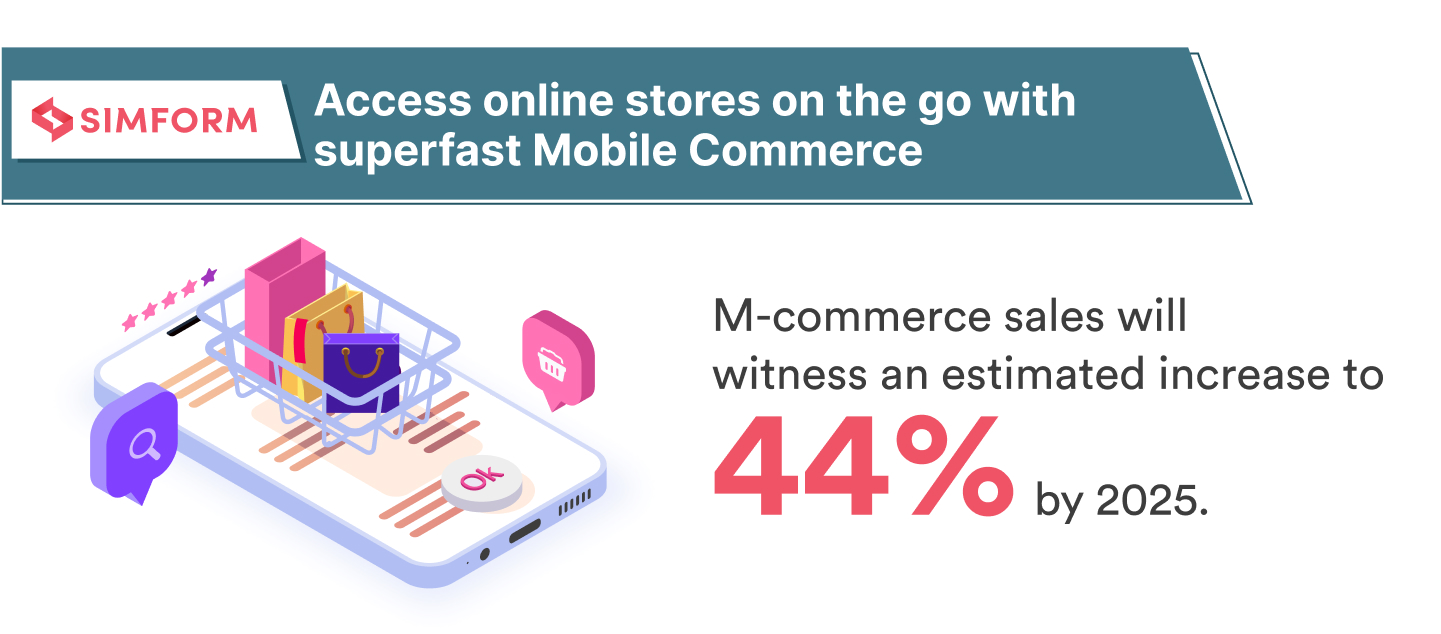 Tap into a bigger user base with mCommerce: Calling mobile commerce an eCommerce trend would be an understatement. It’s a phenomenon taking over online shopping by storm. As of 2023, retail m-commerce sales are anticipated to constitute over 43% of total sales, with an estimated increase to 44% by 2025. Remarkably, m-commerce sales are projected to reach $415.93 billion in 2022, representing a notable 6.0% of the total retail sales for that year.
Tap into a bigger user base with mCommerce: Calling mobile commerce an eCommerce trend would be an understatement. It’s a phenomenon taking over online shopping by storm. As of 2023, retail m-commerce sales are anticipated to constitute over 43% of total sales, with an estimated increase to 44% by 2025. Remarkably, m-commerce sales are projected to reach $415.93 billion in 2022, representing a notable 6.0% of the total retail sales for that year.
Improve brand recognition with easier accessibility: Mobile commerce would let people go through your store while on the go. They can be anywhere doing anything, yet your store would be a few screen taps away. Even the app logo on their phone screen would keep reminding customers of you.
Capitalize on higher conversion rates of tablets: Mobile devices don’t yield as good conversion rates as you’d want. In fact, stats suggest the larger the screen the better the turnout. The tablets (5.5%) also beat mobile devices (3.2%) when it comes to conversion rates.
Cater an omnichannel experience and boost sales: Besides the small screen size being the kryptonite for mobile commerce, nothing stops it from becoming the future of online shopping. Smartphones are a vital interface for delivering an omnichannel shopping experience. They make for easier payments, smooth GPS tracking, simpler comparison with physical products, faster purchases, and more.
Check how we build Swift Shopper- an easy-to-use mobile app that provides a personalized shopping solution.
#7. Headless eCommerce makes the system more nimble and agile
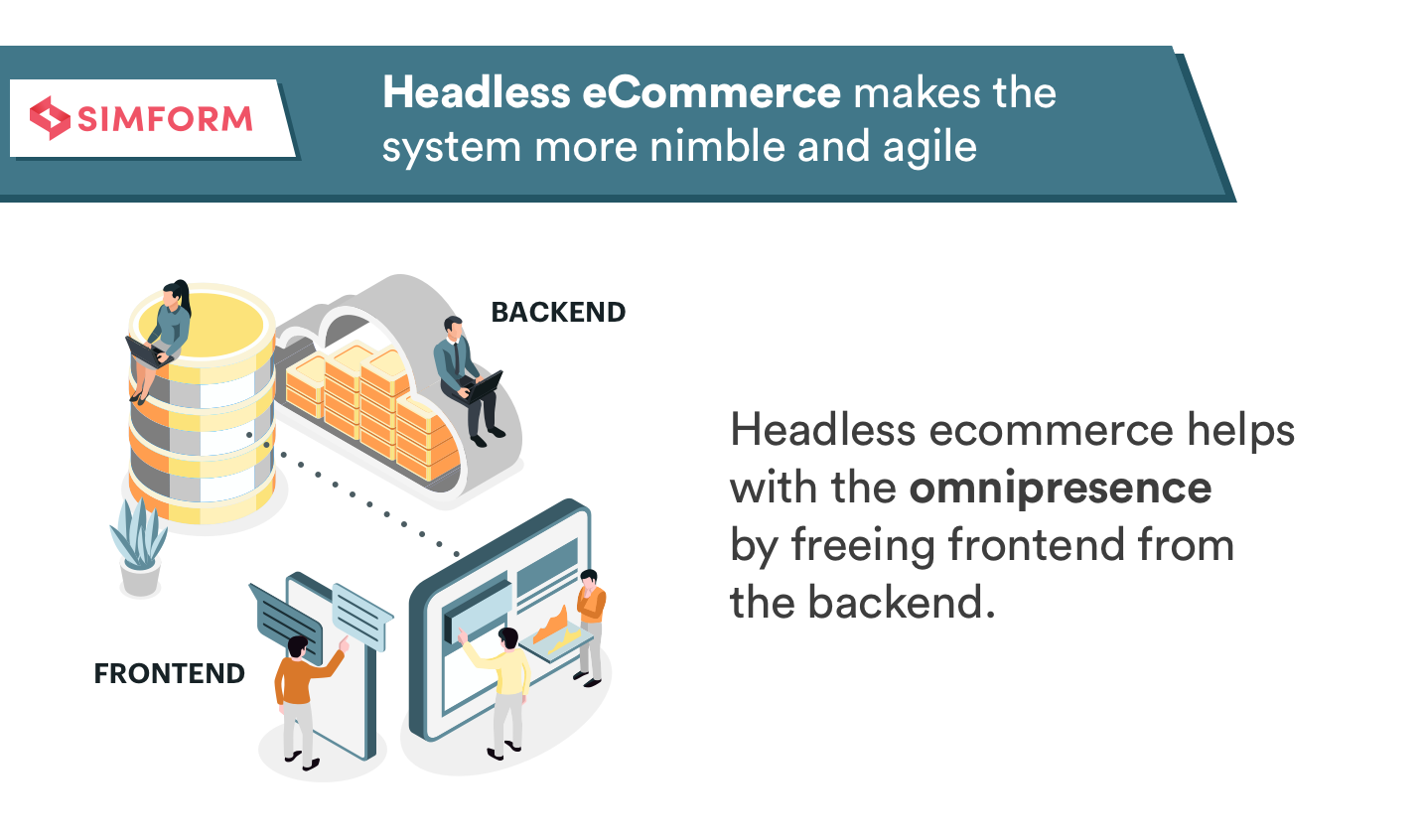
With the abundance of options in the marketplace, it is increasingly difficult to impress shoppers. The continuously shrinking attention spans don’t help the case either. This scenario demands that eCommerce businesses stay flexible and keep things fresh.
Get agile by making the frontend independent of the backend: It’s not easy for large-scale businesses with huge databases to modify things. With conventional architecture, it used to take a lot of work, and yet there used to be the apprehension of so many things going wrong at once.
These circumstances gave birth to a new eCommerce technology trend called headless eCommerce. It is an eCommerce architecture in which the frontend and backend aren’t so heavily dependent on each other, thus making the entire system a lot more agile.
Get more brand recognition with omnipresence: The omnichannel shopping experience isn’t just a buzzword. It is something that businesses need to adhere to, and headless eCommerce helps you establish omnipresence.
The frontend and backend are connected through APIs, which means there are endless possibilities to deploy the frontend. It no longer needs to have the same blueprint as the backend. Marketers can have appropriate frontends for websites, applications, kiosks, refrigerators (yeah, it’s a thing now), and so much more.
Become nimble and gather more profit: The independence of the frontend from the backend also means that you don’t need to wait a lot to update interfaces or roll out changes. The nimble nature of eCommerce would allow you to stay on top of market trends. And the earlier you adapt to market needs, the more profit you get to make.
You can’t see it just as a future eCommerce trend but start thinking of ways to base your eCommerce infrastructure around it.
#8. eCommerce platforms and frameworks for varying needs
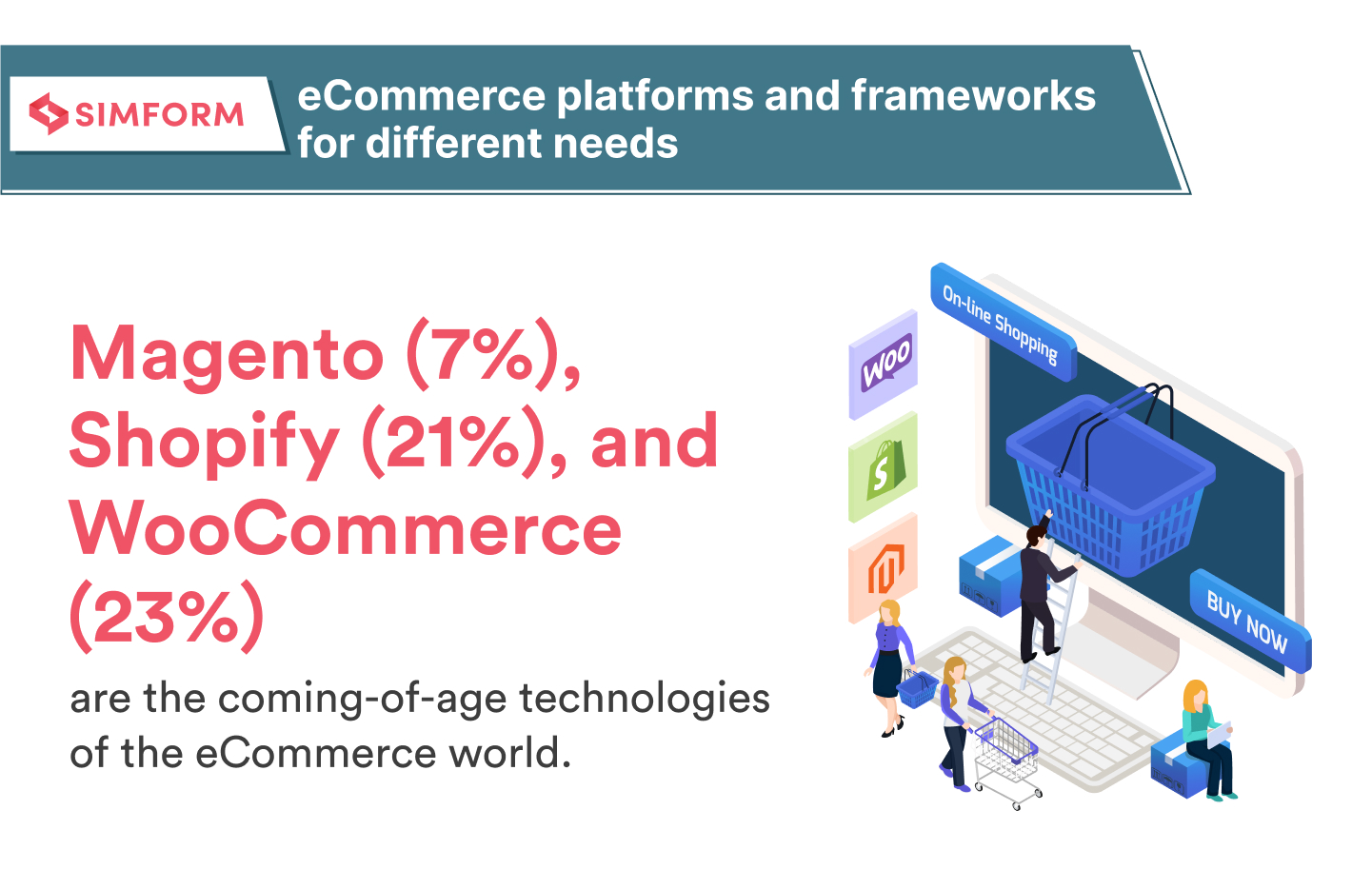 We are both blessed and cursed that there are so many ways to go about eCommerce web development. From platforms that don’t require the developer to write a single line of code to eCommerce platform development from scratch, the options are plenty.
We are both blessed and cursed that there are so many ways to go about eCommerce web development. From platforms that don’t require the developer to write a single line of code to eCommerce platform development from scratch, the options are plenty.
There are variables associated with every business that govern the optimum strategies and processes. It doesn’t make sense for a small eCommerce business to develop a custom-built platform. And if you are expecting to scale massively in the future, it’s better you avoid heavy dependence on a single platform.
Here is a brief of the technologies and platforms trending at the moment when it comes to eCommerce development.
Platforms
Magento (7%), Shopify (21%), and WooCommerce (23%) are titans of the eCommerce world. Together they make up for a huge chunk of active eCommerce websites. The fundamental differences between these platforms are a great indicator of what eCommerce businesses want these days.
One common thread binding all these platforms is that you might need some outside help as the business scales up and gets complicated. Yes, even in the case of Shopify.
Simform can help you get the right eCommerce developers and specialists. It takes care of all your needs right from extending your existing eCommerce development team to hiring eCommerce developers to create an online store from scratch.
Want to build an ecommerce web application for your business?
Frontend
No one likes a sluggish interface or a poorly designed UI/UX. The frontend has become more crucial than ever, and the same applies to any eCommerce website. It needs to be aesthetically pleasing and responsive to grab a visitor’s interest.
There are plenty of fish in the sea when it comes to frontend technologies. You have relatively primitive options such as HTML and JavaScript, and then there are technologies like AngularJS and NodeJS for more efficiency and complexity.
Backend
Reliable logic is the immediate concern when the eCommerce backend comes into the picture. There is, again, a myriad of backend technologies ranging from PHP to Python that you can use in the backend.
Usually, we see NodeJS or Spring at the backend of eCommerce websites. However, if you are expecting to get a lot of traffic on the site, then Magento might be your best bet. It is based on PHP but takes excellent care of the logic. The robust infrastructure won’t even flicker when traffic volume goes up and you’d be able to negate downtimes with ease.
Experience and expertise are the two things you will need irrespective of how you choose for development. Simform has both attributes and can help with your eCommerce development needs.
#9. Better UI/UX leads to more customer retention
Retain more customers with better UI/UX: First impressions are lasting, and 94% are design related. It’s funny how the technologies and platforms we discussed in the previous section don’t even come into the picture if the website is poorly designed.
It should not take a burning trend for you to realize that success has a customer-centric approach at its heart. Companies like Airbnb, Mint, Google, Uber, Apple, etc. owe much of their prosperity to user-centric designs and strategies.
UI/UX has one of the best ROIs: In 2022, Airbnb revamped its website and app, focusing on intuitive navigation and visually appealing design. This increased user engagement, higher conversions, and improved customer satisfaction. Airbnb’s investment in UI/UX significantly impacted its growth and position as a leading platform in the travel industry.
Top eCommerce UX Strategies to Improve Conversion Rates
Better designs lead to improved conversion rates: Making visitors stay longer on the website and having them keep returning to the site is an ability everyone wants to possess these days. The continuously shrinking attention spans make it an even more valuable virtue.
If you haven’t been focusing on better UI/UX already, this is the perfect time to invest in a human-centered design.
#10. Social commerce is critical to an omnichannel experience
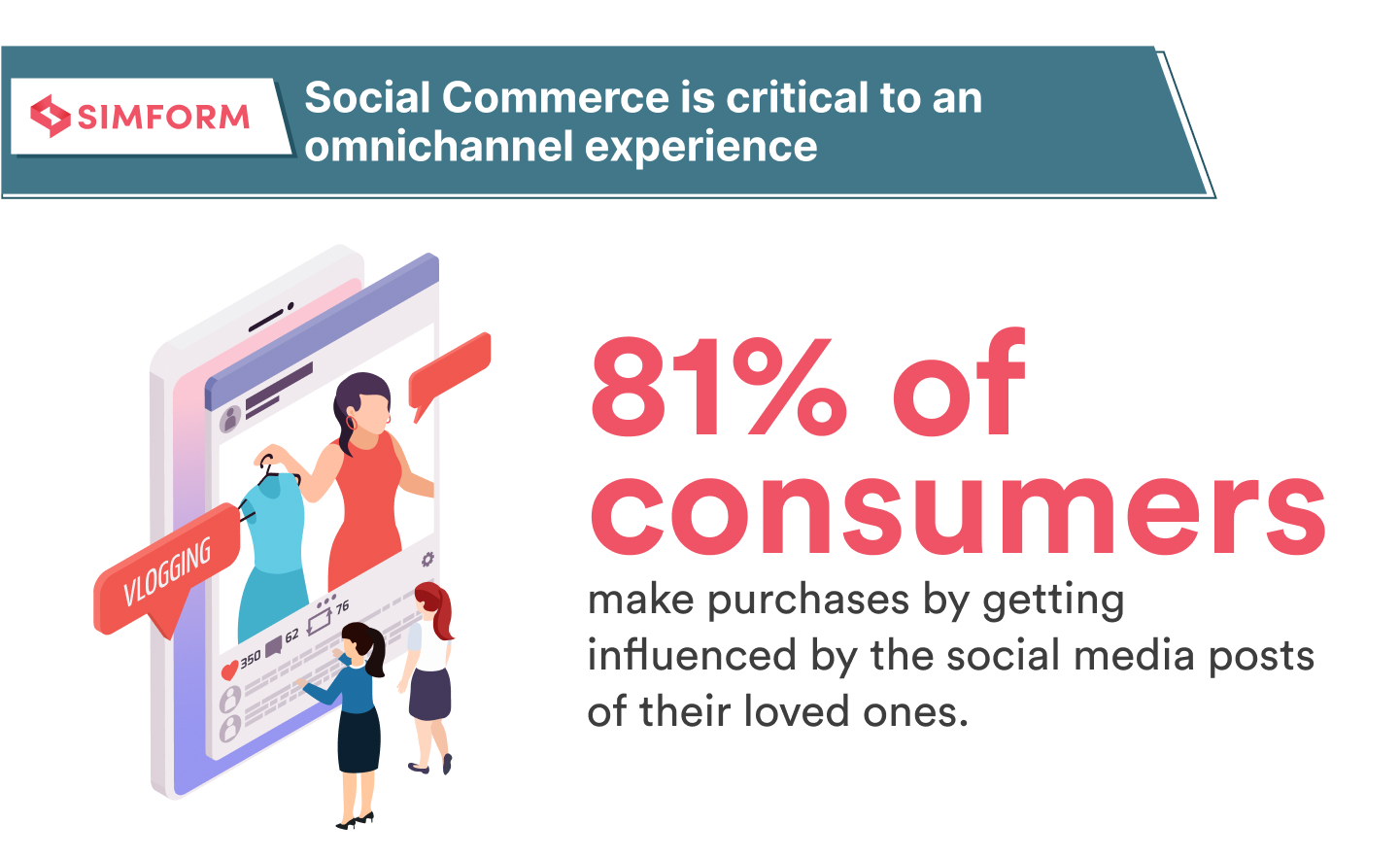 Get more traffic by harnessing social media: There are 4.8 billion social media users worldwide, and social commerce lets you tap into this massive pool of potential customers. No matter how good an eCommerce website you create, it will hardly ever beat the traffic volume social media websites enjoy. You can redirect some of this juice to your website or sell the product on social platforms.
Get more traffic by harnessing social media: There are 4.8 billion social media users worldwide, and social commerce lets you tap into this massive pool of potential customers. No matter how good an eCommerce website you create, it will hardly ever beat the traffic volume social media websites enjoy. You can redirect some of this juice to your website or sell the product on social platforms.
In any case, leveraging social media platforms should be a significant part of your eCommerce strategy. 45% of customers prefer to buy directly from social media platforms in 2023. We can only wonder what can be achieved with a positive social media image.
Utilize positive reviews to get more sales: A positive product review produces an 18% uplift in sales. Plus, 81 percent of the US consumers’ purchase decisions are influenced by their friend’s social media posts.
It’s no wonder people are interested in discovering new products on social sites. In fact, a whopping 55% of consumers have made purchases in this awesome way. So, if you’re looking to boost your product’s value and reach more customers, positive reviews and social
Expand your store to social channels: Another reason social commerce is an eCommerce trend is its ability to improve the omnichannel shopping experience. 13 percent of consumers like to buy products directly from social media with a few clicks.
It only makes sense to take advantage of existing online hubs such as Meta and Instagram. A more prominent role of social media in future eCommerce marketing strategies is inevitable.
#11. Contactless delivery demand after Covid
Post-pandemic, the demand for contactless delivery has widened, ensuring the safe and convenient delivery of essential items, along with profitability, brand loyalty, and increased customer base.
Just like other e-store owners, you can make your offerings contactless by providing features like curbside pickups, smart lockers, QR scanning, contactless delivery, etc.
#12. AI-generated marketing
Create personalized content: Harness AI algorithms to analyze your data, understand your preferences and trends, and enable tailored messaging.
Predictive analytics platforms like Salesforce’s Einstein Analytics and IBM Watson analyze your data to forecast customer behavior, empowering you as a marketer to make informed decisions and enhance your strategies. These valuable insights facilitate targeted campaigns, personalized messaging, and efficient resource allocation.
Automate the process: Leverage AI-driven content generation tools such as Wordsmith and Articoolo to automate the creation of blog posts, social media updates, and videos, streamlining your marketing efforts and saving you time.
Integrate chatbots like Chatfuel and ManyChat to provide instant customer support and personalized recommendations.
#13. Subscription commerce
Subscription services are on the rise in 2023. Consumers are turning towards it due to convenience, personalization and value. While retailers, like you, can benefit from the recurring revenue streams along with increased customer loyalty.
So, opt for any of these three subscription commerce models:
- Access subscriptions: Subscribers pay for exclusive content and perks (streaming services, magazine subscriptions). Examples: Netflix, Forbes, Fabletics.
- Curation subscriptions: Subscribers regularly receive curated “boxes” of products (clothing, beauty products). Examples: FabFitFun, BarkBox, HelloFresh.
- Replenishment subscriptions: Subscribers get recurring deliveries of frequently used products (household supplies) at discounted rates. Examples: Amazon’s Subscribe and Save.
#14. Sustainability
You have likely noticed the increasing concern among individuals about the environment, and you are actively seeking brands that align with your values. By embracing sustainability, you can positively impact the environment and benefit yourself.
For instance, some brands have been taking significant steps towards sustainability. Patagonia, an outdoor clothing company, is known for its commitment to environmental responsibility. They promote recycling, eliminating virgin petroleum fiber, using reusable packaging, and adopting a zero-emission policy that protects the planet.
Another example is the Royal Bank of Canada (RBC). RBC is committed to fighting climate change and bringing cleantech and renewable energy solutions to market through their multi-year commitment called RBC Tech for Nature.
By prioritizing sustainability, you can experience the environmental advantages, cultivate loyal customers, and establish lasting relationships.
#15. Rise in data privacy breach
People love personalized shopping experiences. But they don’t prefer to share personal information due to security concerns. With Google discontinuing support for third-party cookies, businesses are turning to zero-party data to tackle these concerns.
In a survey by Cisco, 86% of consumers prioritize data privacy, demanding transparency and control over how businesses use their personal information. Surprisingly, 47% of respondents switched companies due to dissatisfaction with improper data handling practices.
To prepare for data policy changes and collect zero-party data, you can engage your audience through quizzes, polls, or registrations. These interactive methods not only provide engaging experiences but also offer valuable insights for your business.
#16. Conversational analytics
Provide your customers with immersive experiences and meaningful conversations with the help of NLP and AI.
Scale customer interactions: Enable your customers to interact with eCommerce platforms through text and voice-based conversations.
Enhance customer experience: Transform eCommerce with Virtual Sales Agents. These AI-powered bots revolutionize your customer interactions, driving personalized guidance and sales. They assist you by offering tailored recommendations and excel at up-selling and cross-selling.
Automate support: Use conversational chatbots to help customers whenever and wherever they want. Improve their customer satisfaction by providing accurate and consistent answers to common queries.
Gain valuable insights: Utilize AI to extract insights from customer interactions, written or spoken. Employ statistical algorithms to uncover connections, patterns, trends, anomalies, and root causes, to make informed decisions.
The choice of model depends on the product or service you offer.
The wrap up
The eCommerce industry has been evolving ever since its inception and shows all signs of continuing to do the same in future. The trends mentioned in this article won’t help you stay on top for eternity. You can very well be sure of new technologies showing up, becoming trends, and taking over eventually.
However, these will set you up for the near future- the end of the current evolution stage. You can include them in your ongoing practices and strategies to see improved results. It might be more sales, higher traffic, improved customer satisfaction, more sophisticated infrastructure systems, and so on. These trends might as well be the stepping stone for what comes later, so you don’t want to skip them.
What eCommerce technology trends you think are going to play a significant role in the future? Share your take in the comment section.
Need help implementing these eCommerce technologies? We provide eCommerce development services that will help improve the digital shopping experience on your platform.
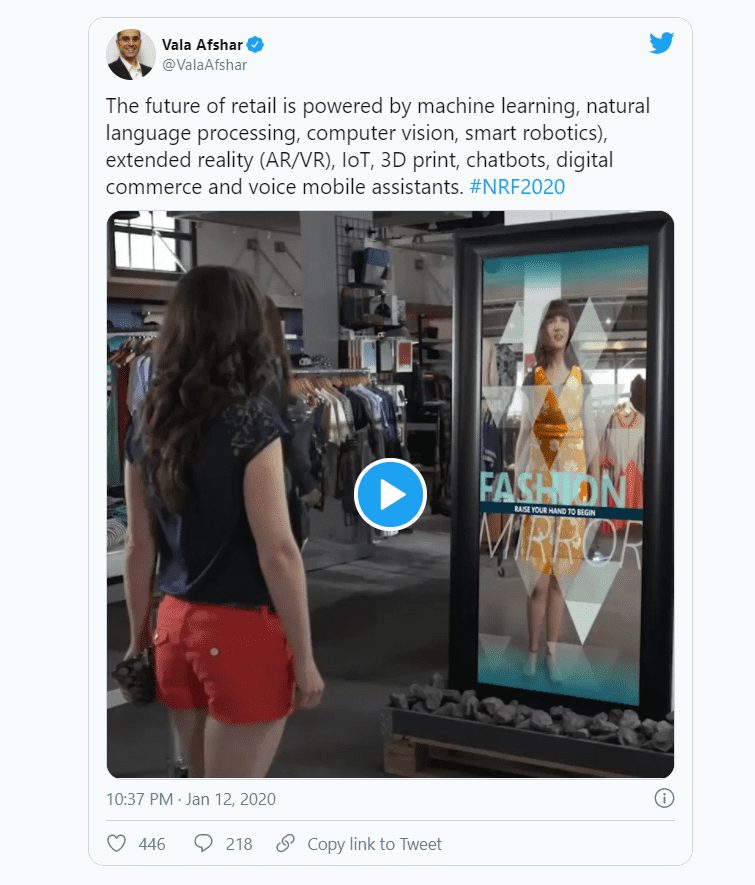

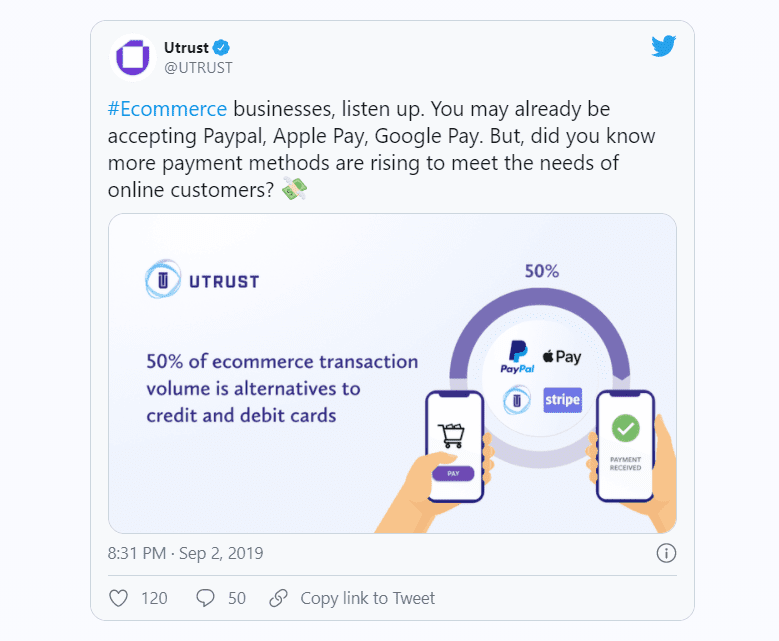
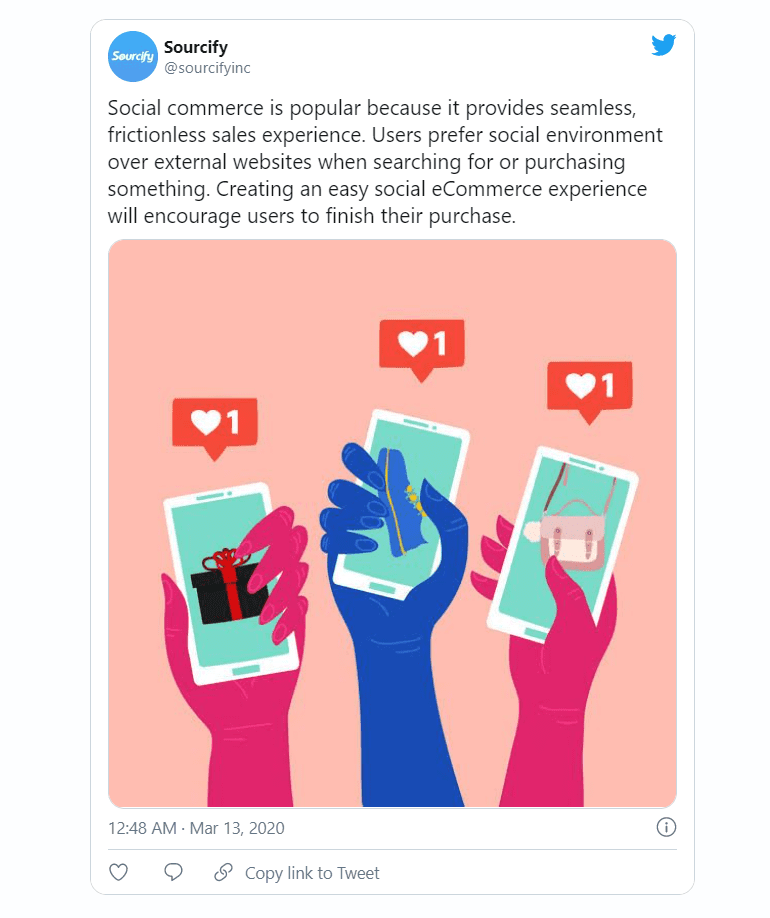
Alexpaul
It was a great and informative post on the future eCommerce trends. Thanks for sharing it. Please keep on writing and enlightening us!
Shubham
Thank you for sharing this blog. It is very helpful for me. Please keep sharing more articles like this.
Jozsi
Green consumerism is on the rise, and brands need to take action. Half of digital consumers say that environmental concerns impact their purchasing decisions. Ecommerce businesses should strive for creating more sustainable practices. People are now becoming more conscious of the environment than ever before, and for the right reasons. Online businesses need to step in and make sure that their practices are environmentally friendly. This includes practices of sourcing products from fair-trade organizations to help create a greener ecommerce environment.
rajeshwari
Amazing article, It clearly explains e-commerce trends. Thanks for sharing this informative blog with us.
debora
This article is very informative, updated and transparent. What a useful information provided by this blog! It’s remarkable. Thanks for helping me out